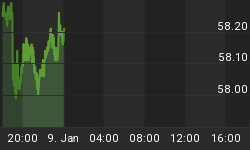LET'S LOOK AT THE S&P DAILY CHART

The trend, since the exhaustion low, remains strong and in order to hold that strength it needs to stay out of the consolidation it just moved up out from. I still believe this is now going to start a larger consolidation pattern or sideways pattern after the next spike up. There is a good chance it could continue to the 1580's but that is more likely to be a high to a sideways pattern than an exhaustion from this level. The last thing on the chart is a one day counter trend down, a wide range day up and Tuesday showed a small range consolidation of the wide range day. If that is all the consolidation that is going to occur then the index will spike up another 23 points immediately. Volume is struggling here but that could be corrected with a few day of increase.
There is a 5 year cycle on the 10th but the longer cycles are usually dominated by the shorter cycles therefore the 15th through 17th are more likely days for a high to the current trend and this would still likely be followed by further distribution or sideways trading.
I've had a number of viewers ask me why the 5 year cycle couldn't have started in March 2003 rather than October 2002. That is possible since March has proved to be significant since the 2000 high. The significance of starting the five year cycle in March, is the index tends to exhaust into the larger cycles for top, so the fastest part of the trend usually occurs at the end of a the trend. If March was the low for the cycle then that would indicate another fast leg up after this run and then further time for the index to distribute. If that is the case, the high to the 5 year cycle would be mid February and a low to start the final drive around Mid November.
I appreciate the question but for now I am sticking with the cycle starting in 2002 because of the 5 repetitions of the 20 year cycle that ended in 2002.
LET'S TAKE A LOOK AT THE US DOLLAR INDEX

The last low marginally broke the trendline from lows to lows indicating some sort of temporary capitulation or exhaustion. Moving above the more recent trendline for highs is not significant. If it can more than four days up, it is now up one day, it would indicate next new low could temporarily end the decline and produce a larger rally as occurred in August. When ever a market starts to run from three ascending or descending trendlines it is in a capitulation or exhaustion style of fast trend and needs a panic to end the trend. Rallies in that style of trend seldom exceed 4 trading days and seldom exceed a ¼ retracement of the move down until they are complete. So if this turns down after a day or two it would indicate this fast trend is still intact. If a rally does exceed 4 days it could still come back for a new low but the probabilities would be for a larger rally to occur after that low.
















